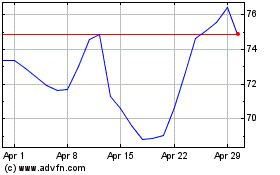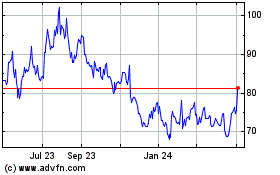United Continental Holdings Inc. recently added nonstop flights
to the Chinese city of Xi'an and plans to roll out service to
Hangzhou in July, part of a high-stakes bet to expand its leading
position in the country.
The big commitment to linking some of China's second-tier cities
directly to the U.S. is made possible because the current
U.S.-China air treaty doesn't include as many limits on the number
of flights to secondary cities, compared with the two largest
Chinese markets. United's efforts revolve around the use of its new
long-range, but relatively small, 219-seat Boeing Co. 787
Dreamliners, which the airline said are the right size and range
for such routes.
United said it also is building on the strength of its hub in
San Francisco, which offers travelers many connections to and from
domestic U.S. airports, and is aided by the airline's long-standing
relationship with China's flag carrier, Air China Ltd.
The goal is to give United an inside track in China, the world's
most populous nation. This year, China is set to overtake the U.S.
as the largest business-travel market, according to a recent study
by the Global Business Travel Association. While more than 95% of
that business is domestic, international travel also is growing
strongly, it said.
But growth to China, which United has been serving for 30 years,
brings its own challenges. U.S. and Chinese carriers have ramped up
their capacity, offering more seats and flights than demand
warrants, which is pinching prices. The U.S.-Chinese aviation
treaty caps flights to Beijing and Shanghai—and U.S. carriers are
close to their limit, restricting future opportunities there. Also,
China's once-torrid economic growth has slowed.
Even so, Chinese demand for flights to the U.S. has doubled in
the past five years, said Brian Znotins, United's vice president of
network. "It's still a huge, hot economy," he said. "The middle
class is really booming. And the secondary cities are the growth
engine."
According to the Centre for Aviation, an airline think tank in
Sydney, the four largest Chinese airlines offered 2,028 weekly
flights to the U.S. last summer, compared with 1,853 flights from
U.S. carriers to China. That is sharp change from 2011, when U.S.
airlines operated nearly twice the number of flights to China as
Chinese carriers operated to the U.S.
United's move comes as the airline has slipped to third place in
traffic among its U.S. rivals. Its pretax margins lag behind its
largest competitors and it has a new chief executive from outside
the industry, who is learning as he goes. CEO Oscar Munoz took a
five-month medical leave after he suffered a heart attack in
October. He underwent heart-transplant surgery in January and
returned to work in March.
China, where United is the leading U.S. operator, is a bright
spot, with flights there overall as profitable as those in its
domestic network, said Mr. Znotins.
"Now is the time to create a beachhead there," before China and
the U.S. eventually adopt a liberal "open skies" air treaty and
competition heats up, said John Thomas, leader of L.E.K.
Consulting's global aviation practice.
United's homegrown competitors, American Airlines Group Inc. and
Delta Air Lines Inc., said they are for now concentrating their
efforts on building up in Shanghai and Beijing. The two currently
are vying for U.S. government permission to fly daily between Los
Angeles and Beijing. American also is adding service to Hong Kong,
another destination where United is dominant.
Flying direct to smaller Chinese cities "is something we are
looking at as a longer-term opportunity," said Paul Baldoni,
Delta's managing director for the Atlantic and Pacific networks.
"But we don't think at this point it's economically viable."
However, some European airlines are using that strategy, and
Chinese carriers are beginning to explore it.
The Air China partnership is important to United. The two have
an extensive code-sharing arrangement in which they sell each
other's flights as their own on 41 round-trip routes in China, 65
round-trip routes in the U.S. and 16 trans-Pacific routes between
the U.S. and China. United, on its own long-haul planes, carries
3,000 passengers a day in each direction between the two nations,
including traffic to and from Hong Kong. Delta carries about 1,500
a day in each direction.
Aside from Xi'an, the capital of Shaanxi province, with a
population of 8.7 million, United flies to Chengdu, the
10.5-million-population capital of Sichuan province. The Chengdu
flights, which began in 2014, operate three times a week in winter
and four times a week in the summer. Mr. Znotins said the planes
are about 75% full and the number of passengers buying these
flights is growing faster in China than in the U.S.
Xi'an, a tourism destination, receives United nonstop flights
three times a week during the summer, with the route set to go
dormant in late October for the rest of the year. The ancient city
is home to the Terracotta Army of early Emperor Qin Shi Huang and
was the eastern starting point of the Silk Road trade route.
Hangzhou, the capital of Zhejiang province, will receive daily
United nonstop flights starting in July. Hangzhou, with a
population of nine million, is the home of e-commerce company
Alibaba Group Holding Ltd.
Mr. Znotins said there are a dozen cities with large populations
in the Chinese hinterland that could be ripe for nonstop service.
He declined to say whether United is receiving any subsidies from
the new Chinese destinations. "It's not uncommon when we start a
new route to have incentives," he said, adding they are "pretty
commonplace in cities of the world that don't have [direct] service
to the U.S."
(END) Dow Jones Newswires
May 31, 2016 19:25 ET (23:25 GMT)
Copyright (c) 2016 Dow Jones & Company, Inc.
Alibaba (NYSE:BABA)
Historical Stock Chart
From Mar 2024 to Apr 2024

Alibaba (NYSE:BABA)
Historical Stock Chart
From Apr 2023 to Apr 2024
